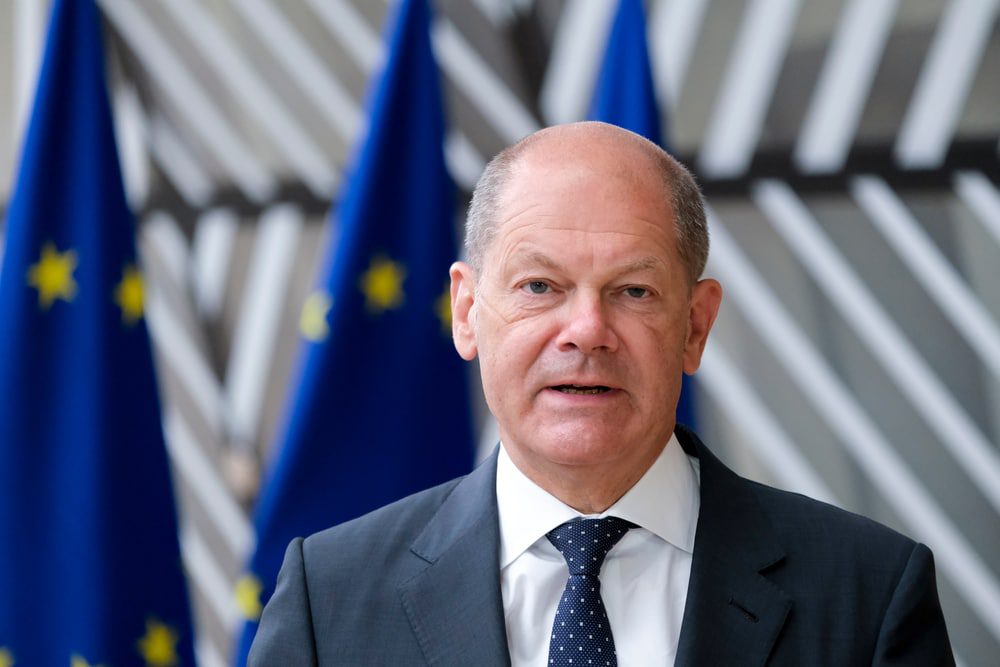Amid broad discontent over his country’s perceived ambivalence towards Russia, German Chancellor Scholz paid U.S. President Biden a diplomatic visit. It’s his first to the White House since coming to power last December.
Their Monday meeting of February 7th proved mainly a symbolic gesture of unity, intended to allay concerns of Germany’s partners, who view Germany’s reliability with increasing skepticism. It was only a month ago that Emily Haber, the German ambassador in Washington, wrote in a leaked diplomatic cable that “Berlin has a problem” when it comes to its image in the U.S. Much of that distrust flows from Germany’s continued refusal to send any military materials to Ukraine—apart from 5,000 helmets, as we already reported. As the NATO covenant appeared to show fissures over the last couple of weeks, a public reaffirmation of the two allies’ shared commitments was of the essence. Germany, current holder of the presidency of the G7, is the United States’ most important military and economic partner on the European continent.
Judging from the joint press conference later that day, both parties’ desire to present an ironclad front was patently obvious. A “united approach to deterring Russia’s threats against Ukraine and the longstanding principles of rule-based international order,” was, according to Biden, in fact “top of our agenda.” The U.S. President restated his and his allies’ pursuit of “diplomatic resolutions of this situation,” assuring that they’re “ready to continue talks in good faith with Russia.”
While praising Germany as a “leader in pushing de-escalation of tensions and encouraging dialogue through the Normandy Format,” Biden stressed the point that should Russia “further invade” Ukraine, “we are jointly ready and all of NATO is ready.” An agreement on “a strong package of sanctions that are going to clearly demonstrate international resolve and impose swift and severe consequences if Russia violates Ukraine’s sovereignty and its territorial integrity,” had also been reached, the president said. Scholz appeared to agree to this “strong package:” “we’re absolutely united and … we will not be taking different steps. And they will be very, very hard (for) Russia,” Scholz said.
Yet, when pressed by reporters, he avoided making a clear pronouncement on the future of the Nord Stream 2 gas pipeline, through which Russia would export its gas to Germany. While it is working on renewable energies and eyeing a carbon neutral economy by 2045, Germany is still dependent on Russia for a large portion of its gas supply. Instead, he said it was “part of this process that we do not spell out everything in public.” The vague statement has cast doubts on how aligned the two partners—on the topic of sanctions, if not obligations in the context of NATO—really are. Biden was far more direct, saying that, in the eventuality of a Russian attack, “there will be no longer a Nord Stream 2. We will bring an end to it.”
The chancellor seemed to play a balancing game, letting Biden make such clear-cut, absolutist remarks, without offering any contradictory ones himself. Germany has delayed approval of the Nord Stream 2 pipeline until at least the second half of 2022, but has thus far refused to cancel the nearly completed project. The country’s reluctance has ruffled U.S. lawmakers and officials. White House spokesperson Jen Psaki said the U.S. would work with Germany “to ensure that Nord Stream 2 does not move forward should Russia invade,” yet German officials have not acceded to such a move and say all options are on the table.
To counteract the energy shortages—a growing concern of Europeans—that could arise if the Nord Stream 2 deal is scuttled, Biden said the U.S. is “looking at opportunities.” By reaching out to other exporters around the world, he thinks “a significant portion” of what would be lost could be made up for. Gas imports are mainly used for heating and cooking during the winter months.
President Biden also advised the 30,000 U.S. citizens living in Ukraine to leave the country, saying that he’d “hate to see them get caught in a crossfire if in fact they did invade. And there’s no need for that. And I—if I were (them)—if I had anyone there, I’d say leave.” Moscow has been consistent in its insistence that it does not want war with Kyiv, while Washington and European allies say that the 100,000 or more Russian troops deployed near the border with Ukraine could move into the neighboring country “at any time” and potentially take the capital within “two days.”
For Chancellor Scholz and his entourage, it’s all hands on deck. With his popularity at home having dropped by 17 percentage points, his visit next week to both Ukraine and Russia is crucial for reinstilling confidence. After finishing up in Washington, he will meet with EU officials and heads of the Baltic states this week.






